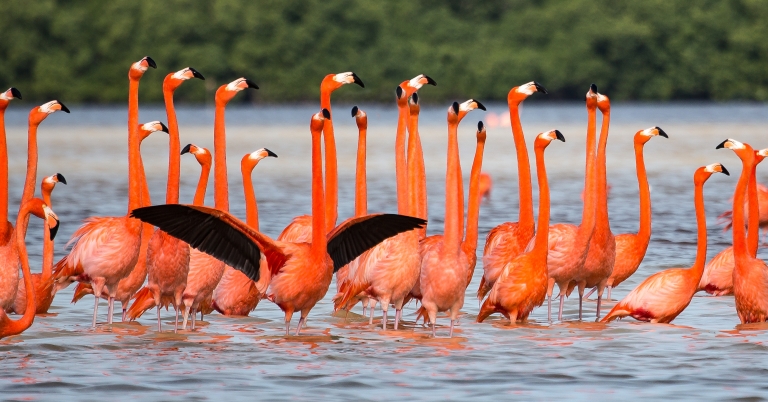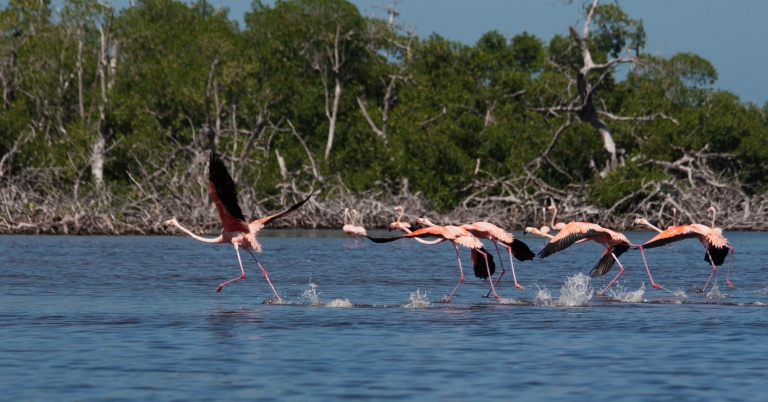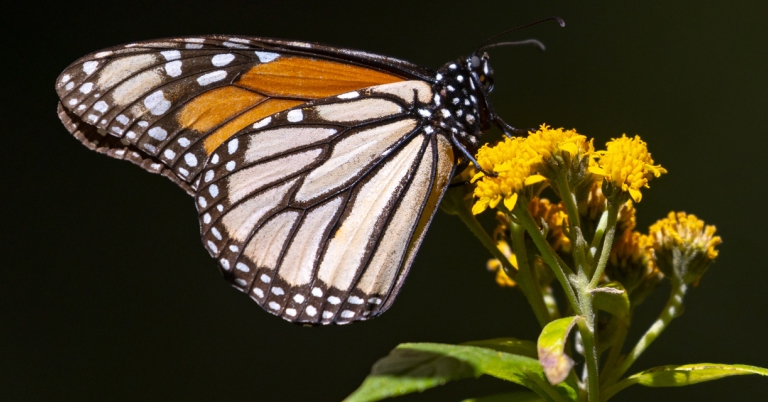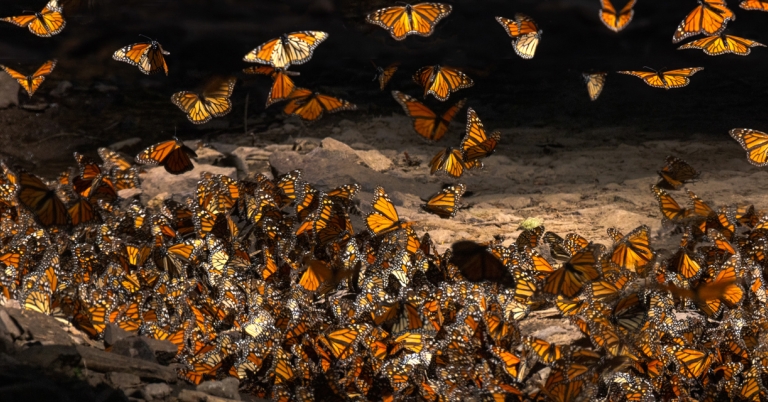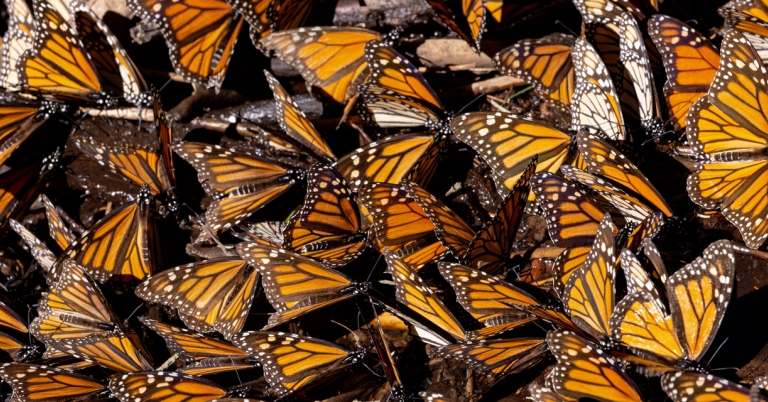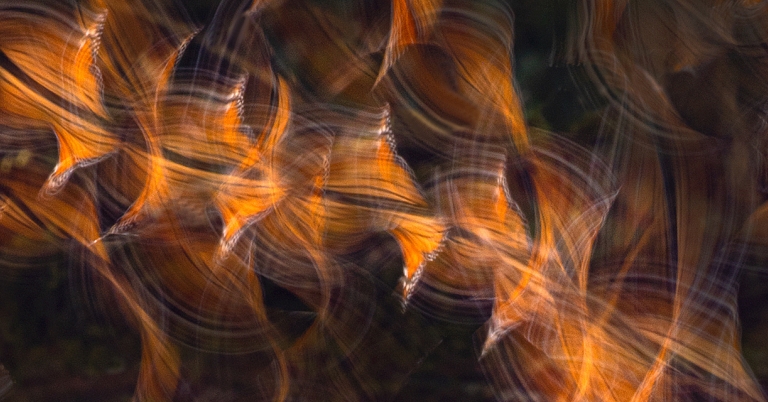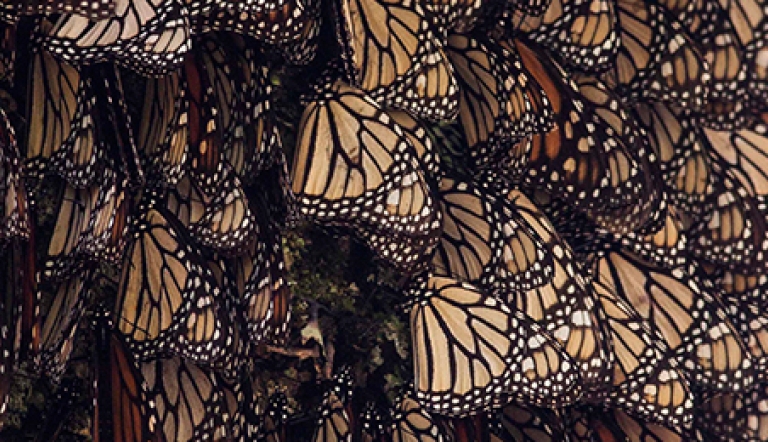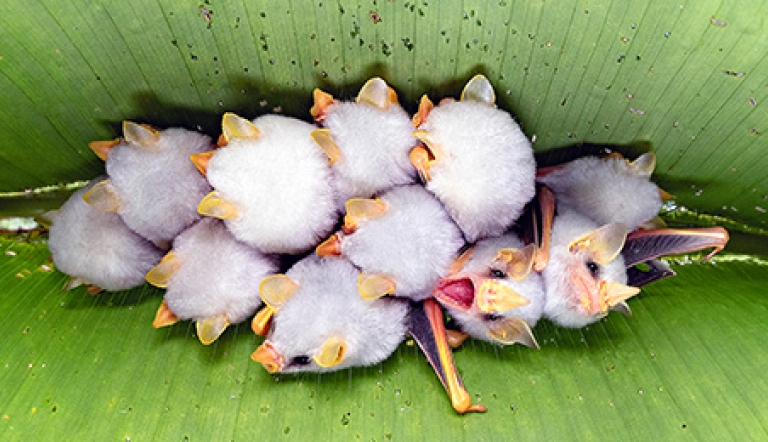Mexico | Mystical Migration of the Monarch and the Fabulous Flamingos
Date:
Activity Level:
Duration:
Price:
Interests:
About this trip
 On this trip you will observe and photograph two fascinating creatures: flamingos and monarch butterflies. Begin your journey in the Yucatan Peninsula with opportunities to photograph flamingos during their courtship displays, roosting, and while in flight. Continue west to Angangueo, where you'll visit multiple monarch butterfly reserves including the famous El Rosario. Learn about their fascinating life story and migration. It is this natural wonder that you will be filming and photographing high in the mountains of southern Mexico at the ends of the Earth. With tips, techniques and personal instruction from a top digital photography expert, Todd Gustafson, you will return with an amazing portfolio of colorful images and a new sense of wonder.
On this trip you will observe and photograph two fascinating creatures: flamingos and monarch butterflies. Begin your journey in the Yucatan Peninsula with opportunities to photograph flamingos during their courtship displays, roosting, and while in flight. Continue west to Angangueo, where you'll visit multiple monarch butterfly reserves including the famous El Rosario. Learn about their fascinating life story and migration. It is this natural wonder that you will be filming and photographing high in the mountains of southern Mexico at the ends of the Earth. With tips, techniques and personal instruction from a top digital photography expert, Todd Gustafson, you will return with an amazing portfolio of colorful images and a new sense of wonder.
Highlights
- Observe and photograph flamingos during their courtship displays, roosting, and while in flight.
- Visit multiple monarch reserves on foot or horseback, where millions of individual monarch butterflies gather each winter.
- Photograph the dramatic colors of the butterflies and as they hang in clusters from the trees, drink from streams, feed on wildflowers, and soar in the air above.
- Immerse yourself in the delicate sound of butterfly wings as tens of thousands of monarchs take flight when the sun emerges.
- Understand the story behind every photograph with site lectures on local wildlife, traditions, and history.
- Discuss results of applied techniques and present suggestions during evening feedback sessions.
Meet your leader
 Todd Gustafson
Todd Gustafson
Todd Gustafson is an internationally renowned photographer and videographer who has been photographing nature, wildlife and natural history around the world for the last 3 decades. Capturing beautiful light on beautiful subjects in an artistic way at the decisive moment is a continuous personal goal. He is a seasoned photo safari leader who combines his passion for photography with his love of exploration. He guides nature and photo enthusiasts through breathtaking landscapes and habitats in search of the dramatic and the unexpected. This enables them to capture the world’s beauty at its most dramatic. Todd’s approach to leading photo safaris is rooted in his deep respect for nature and culture. He emphasizes the importance of ethical photography, encouraging participants to tread lightly and leave no trace. For many years, Todd photographed and worked as a clinician/teacher for NIKON Corporation. In April 2015, Todd switched equipment and now shoots Canon equipment.
Activity Level 4: Moderate-Strenuous
This journey is for fit and active nature enthusiasts. Daily activities last for 5 or more hours. There are challenging excursions to butterfly colonies that may require walking for approximately 2 miles at altitudes of up to 10,660 feet on some trails that are narrow and rugged. These may involve both steep uphill and downhill hikes of 30 minutes or more (hiking at your own pace), and require horseback riding for part of the way; please note there is a maximum weight limit of approximately 260 lbs to ride the horses. Restrooms are only available at the base of the mountain. Weather in the Central Highlands during the migration is typically cool and dry with average temperatures in the 50s. Though days are typically sunny, there can be some windy conditions, and nights occasionally drop below 30°F.
Additional Notes
During site visits, the days entail walking around the butterfly sites on your own and photographing and watching butterflies. Please be prepared to be independent during butterfly watching.
Please also see the information about Safety & Risk Management under the Travel Info tab.
$7,995
Per person
About this price
Land cost only. Does not include round-trip airfare to and from destination.
Single room supplement $1500
What makes us different
Rich content
Wildlife up-close
Value for your money
Meaningful experiences
Service anytime
Expert guides
Daily Itinerary
Print ItineraryMerida
Celestun
Celestun
Celestun
Angangueo
Angangueo
Angangueo
Mexico City
Mexico City
Pricing
Print Pricing$7,995
Per person
About this price
Land cost only. Does not include round-trip airfare to and from destination.
Single room supplement $1500
What's Included
- Activities and meals as mentioned in itinerary
- Tips for everyone except Guide
- Internal flights relevant to itinerary
- Airport transfers
- Full time guide for the duration of your program
- Private transportation and driver for the duration of the program
- Carbon Offset
- Non alcoholic beverage with meals
What's Not Included
- International airfare
- Tips for guide
- Travel Insurance
- Items of personal nature
Pricing Details
Payments associated with the land program (not including any additional services such as pre or post nights) will be made directly to Todd Gustafson. A $1000 per person deposit and enrollment form is due to hold your space on this trip. This deposit is not refundable.
Holbrook Travel strongly recommends the purchase of travel protection for medical emergencies while traveling and to protect your investment. Please note the purchase of Cancel for Any Reason Coverage or to exclude pre-existing conditions with Trip Cancellation coverage may require policy purchase within 10-14 days of your initial deposit, depending upon the provider.
Single room supplement $1500
Final payment due date: November 22, 2025
Travel Info
Print Travel InfoSafety & Risk Management
Please note that this program visits the Mexican state of Michoacán, which the U.S. State Department has long designated a Travel Advisory Level 4 due to criminal activity. Mexico City is designated a Level 2 and Yucatán state is a Level 1. Holbrook has operated programs to view the monarch migration in these locations for many years without incident, and we have strict safety protocols in place for all our destinations. However, it is ultimately up to each traveler to make their own assessment regarding safety and risk. Travelers are advised to visit https://travel.state.gov for more information.
Entry & Exit Requirements
U.S. citizens must have a valid passport book to enter Mexico. Passports must be valid for at least the duration of your stay. As this requirement is subject to change at any time without notice, we recommend at least 6 months’ validity. A passport card (as opposed to a book) is not acceptable for entry by air.
If you are not traveling with a U.S. passport, please check with the Mexican Embassy for the requirements based on your nationality.
Health Information
IMMUNIZATIONS
The Centers for Disease Control recommends that all travelers be up-to-date on routine vaccinations such as measles-mumps-rubella (MMR) vaccine, diphtheria-tetanus-pertussis vaccine, varicella (chicken pox) vaccine, and your yearly flu shot, as well as the COVID-19 vaccine, before every trip.
There are no vaccinations required for entry into Mexico. Though not required, the CDC recommends inoculation against hepatitis A, hepatitis B, and typhoid for most unvaccinated travelers to Mexico.
Please consult your physician for additional information and recommendations based on your individual circumstances.
Malaria & Other Insect-borne Illnesses
The CDC does not consider travelers to the Mexican states of Yucatán or Michoacán or to Mexico City to be at risk for malaria. If you are concerned about malaria prevention, please consult your physician.
Other insect-borne illnesses are known to occur in Mexico, including dengue fever, Zika virus, chikungunya, and others. These are very rare at the high elevations of Michoacán visited on this program. In Yucatán, travelers should take precautions to protect against insect bites. The CDC recommends that you cover exposed skin with lightweight, long-sleeved shirts and pants, consider treating clothes with permethrin, and use an insect repellent containing an EPA-registered active ingredient like DEET, picaridin, or oil of lemon eucalyptus (OLE). Apply sunscreen first, followed by the repellent, ideally 20 minutes later.
Be careful when applying products containing DEET, as it can damage or dissolve certain synthetic fabrics as well as plastic, rubber, vinyl, or elastic materials, such as those used in camera equipment, phone cases, sunglasses, or watches. Additionally, some research suggests that when DEET and picaridin enter local waterways, they can be harmful to amphibians and other wildlife. When selecting a repellent, it is ultimately up to each traveler to weigh the risks and benefits of different options, keeping in mind both environmental factors and the importance of protecting against illness.
Cases of Rocky Mountain spotted fever, a tick-borne illness, have been reported in the Yucatán Peninsula. To protect against tick bites, follow the measures noted above. After spending time outdoors in grassy or wooded areas, the CDC recommends showering and conducting a full-body check for ticks. If you find a tick attached to your skin, use tweezers to safely remove it as soon as possible.
As a precaution, the CDC advises women who are pregnant to consider postponing travel to any area where Zika virus transmission is ongoing.
Altitude Sickness
The high elevations of Michoacán might cause some travelers to experience altitude sickness during this program. Please discuss appropriate preventative measures with your personal physician prior to travel.
The most common form of the illness is acute mountain sickness (AMS). Symptoms generally include: headache, fatigue, loss of appetite, nausea, and at times, vomiting. The two more serious, and less common, forms of altitude illness are high-cerebral edema (HACE) and high-altitude pulmonary edema (HAPE). HACE and HAPE can be potentially fatal if left untreated. Symptoms include: profound lethargy, extreme confusion, and increased breathlessness.
To alleviate symptoms of altitude sickness: stay hydrated and well-rested; eat high-carbohydrate foods; and avoid heavy, fatty foods, alcohol, sleeping pills, or narcotics during travel and in the days before arrival. Avoid heavy exercise while staying at high elevations.
Visit the CDC website for more information.
Travelers’ Diarrhea
The CDC warns that travelers’ diarrhea is the most common travel-related illness. Consumption of contaminated food and water may cause diarrhea. To avoid this, do not drink tap water, and use bottled water to brush your teeth. Avoid ice and uncooked vegetables or fruit without a peel. When in doubt, ask your guide. Restrict yourself to cooked food at restaurants, and avoid food sold on the streets. If you contract diarrhea, it is very important to drink large quantities of purified water. Consult your doctor for appropriate medication should you contract diarrhea.
SUN EXPOSURE
The effects of the sun can be damaging to the eyes and skin. Spending time outdoors exposes you to the sun’s harmful ultraviolet (UV) rays, even on cloudy days. To protect yourself from the sun, use a broad spectrum sunscreen of at least SPF 15, protect skin with clothing, wear a wide-brimmed hat and sunglasses, and drink plenty of fluids.
Respiratory Illness Protocols
Please review our Respiratory Illness Protocols page, which explains our policy and procedures if you or another traveler should develop symptoms of a respiratory illness during your trip. Your participation in a Holbrook Travel program indicates that you are in agreement with these protocols.
Resources
Print ResourcesSuggested Packing List
Everyone has personal preferences when it comes to packing; for this reason, the information below is offered as a general guide and not a definitive list. You know yourself best: Use your discretion and pack what you think will serve you, based on your personal preferences and specific itinerary.
You may find many of the items below in the New Headings Gear Store. Use code HolbrookGuest10 for a 10% discount on your purchase.
CLOTHING
Casual, comfortable field clothes are suitable for most activities. Bring enough clothing suitable for the length of your program. If you prefer to pack light, note that many hotels offer laundry services at additional cost. If you plan to hand-wash items, remember that humidity in Yucatán may delay drying time. Make sure to bring warm clothes, as the temperatures at 10,000 feet can be at or below 30 °F in the early morning. It can also be windy on the mountains.
Pack clothing that can be worn in layers to adapt to weather changes throughout the day. Clothing that wicks away moisture and dries quickly is recommended. Versatility is key.
- A combination of short-sleeved and long-sleeved shirts suitable for layering; lightweight for sun and insect protection in Yucatán, and warmer for Michoacán
- Shorts
- A combination of light- and medium-weight long pants (such as jeans, khakis, or field pants)
- For Yucatán, lightweight, quick-drying long pants for sun and mosquito protection; jeans tend to be uncomfortable in hot and humid conditions.
- Undergarments
- Warm sleepwear
- Lightweight jacket or sweater/sweatshirt
- Parka or other outerwear: At the monarch sites, temperatures may be near freezing for the first hour or two of the day.
- Socks – Bring extra pairs.
- Shoes – You'll likely want at least one pair of hiking boots for dusty forest trails or riding horseback (if desired), and/or a pair of comfortable, well-worn, closed-toe shoes with rubber soles suitable for walking on cobblestone streets, gravel paths, and uneven surfaces. In addition, you may want a pair of sturdy sport-strap sandals (e.g. Keens, Tevas, or similar) and/or casual flip-flops or sandals.
- Rain gear – Rain is infrequent, but a lightweight rain jacket or hooded poncho comes in handy should a slight drizzle or snow flurry occur at the monarch sites. It also makes a great layer for added warmth.
- Headgear – Visor or wide-brimmed sun hat, plus a warm cap or wool hat
- Bandana, scarf, or neck gaiter – These can be helpful for sun protection and on dusty trails.
- Gloves
- Hand warmers – Hand warmers are small, heated pouches found in outdoor sections of many large retail stores as well as specialty sports and camping stores. When you open their packaging, the oxygen reacts with the powder inside the pouches to create heat, and after about 30 minutes they heat up to 120 °F, last for about 6-10 hours, and provide considerable warmth. They come in a variety of sizes and are inexpensive. These have been very popular with travelers in the past and are another way to ensure that you are comfortable during the cool mornings and nights. Due to current security regulations at airports, we recommend you pack these in your checked luggage, NOT your carry-on bag.
Personal Toiletries
Pack toiletries based on your personal preferences and habits. Below are just a few recommendations to keep in mind.
- Shampoo, conditioner, lotion, deodorant/antiperspirant, etc. – All hotels provide shampoo and soap, but you may wish to bring your own from home if you prefer. If possible, avoid strong fragrances if you are sensitive to insect bites and in consideration of your fellow travelers.
- Soap and washcloth or a small, quick-drying microfiber towel – These items are not always standard in hotels outside the US, so you may wish to bring them with you.
- Hairbrush, comb, hair ties, shower cap. Most—but not all—hotel rooms provide a hair dryer, but you may wish to bring one from home.
- Toothbrush and toothpaste
- Razor
- Ear plugs, especially if you are a light sleeper
- Personal hygiene products
- Insect repellent with an active ingredient – Note that DEET can damage or dissolve certain synthetic fabrics as well as plastic, rubber, vinyl, or elastic materials, such as those used in camera equipment, phone cases, sunglasses, or watches.
- Sunscreen and lip balm with SPF
- Aloe vera gel
- A travel pack of tissues – also useful as napkins or toilet paper if needed, as it may not be available at all stops
In addition to your personal toiletries, it is useful to pack a small medical kit, which you can easily prepare. Helpful items might include: bandages, antihistamine, a pain reliever (may be helpful for altitude headaches), motion sickness and/or altitude sickness medication (if you are prone to either), anti-diarrhea medicine, individually wrapped pre-moistened towelettes and/or hand sanitizer, antibiotic ointment, anti-fungal cream, moleskin for blisters, eye drops, tweezers, a mini sewing kit, and an extra pair of disposable contact lenses or eyeglasses if you wear them.
Days before you leave home, you may wish to consider spraying any clothing, socks, and shoes that will be worn in lowland, tropical sites with permethrin, an anti-parasite medication, to repel irritating pests and prevent the spread of disease. A recommended brand is Sawyer. Carefully read all instructions before use. Please note permethrin is highly toxic to cats and fish, and some aerosol products may be harmful to birds. Side effects may include minor itching, burning, or redness. You may want to use a laundry marker to label and keep track of which socks are permethrinized. Only one application per item is necessary; permethrin on treated clothes remains effective through several washings. Permethrin should NOT be applied directly to skin.
MISCELLANEOUS
Remember to pack valuables such as your passport, cash/credit cards, and medications in your carry-on luggage.
- Passport and photocopies of all travel documentation
- Personal insurance card and travel insurance information
- Money – ATM/credit card and cash ($45 per day for guide and staff tips, plus additional cash for spending money, souvenirs, etc.); small bills in good condition are recommended.
- Prescription medicines (if applicable), with a copy of the prescription
- Sunglasses with strap
- Small day pack for carrying water, camera gear, rain gear, clothing layers, etc.
- Flashlight and/or head lamp
- Travel alarm clock or inexpensive waterproof wristwatch with alarm – Not all hotels provide alarm clocks.
- A pocket calculator or phone to assist with conversions and currency exchange
- Binoculars with lens cleaner
- Camera and related equipment, such as charger, lenses, and extra memory cards – See below for a sample gear list from Todd. Also, be prepared to pay an extra park fee for use of a video camera (anything that looks professional-level) while in the parks.
- Reusable water bottle – Plan to buy bottled water, but you may wish to bring an extra container for refilling.
- Non-perishable snacks
- Pocket-knife or multipurpose tool – Pack in your checked luggage.
- Notepad or travel journal and pen
- Music or reading material for down time, long bus drives, or on the airplane, and a portable bright light to read by
- Collapsible walking stick with rubber tip – Pack in your checked luggage.
- A small quantity of laundry detergent if you’ll be washing clothing by hand
- Zip-top style bags – useful for packing toiletries, sorting clothing, storing damp or muddy shoes, or as a dry bag for protecting electronics
- Money belt
- Chargers for electronics
- Dry bags for electronics
Sample Camera Gear List from Todd
- (2) R5 camera bodies - Chargers
- (2) 512 gig CF Express cards
- (2) 256 gig CF Express cards
- (2) 4 TB drives for digital storage
- Laptop – Mouse and Link-power cord
- TODD-PLUG (Same as USA)
- AA Battery Charger 110-220 volts
- AA rechargeable Batteries (8)
- AAA rechargeable Batteries (16)
- (2) Rapid Strap camera straps
- Gitzo tripod
- Fluid video head
- Bolt macro Flash (4) AA
- 100 mm Macro
- 14 –35 mm
- 8-15 mm
- 600 mm
- (2) 2X teleconverters
- 100-400mm
- Camera cleaning kit: Eyelead sensor cleaner, micro cloth, micro tools

Questions
For more information contact Todd Gustafson at gustaphoto@aol.com or Pelin Karaca at pelin@holbrooktravel.com
